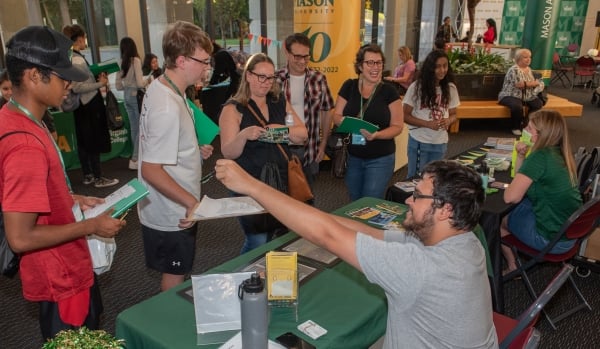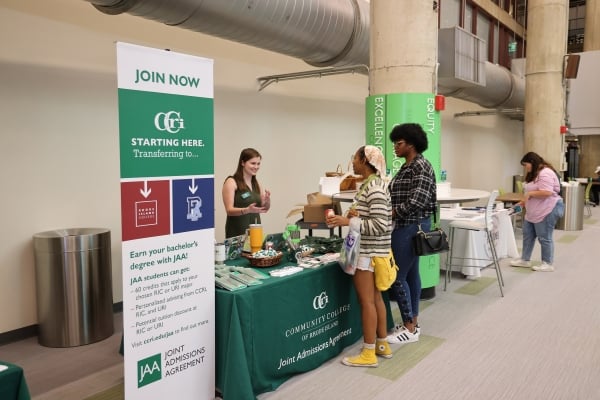You have /5 articles left.
Sign up for a free account or log in.

The ADVANCE program, a guaranteed admissions partnership between Northern Virginia Community College campuses and George Mason University, is the most successful transfer pathway in Virginia.
Northern Virginia Community College Photography
It’s been a good year for guaranteed admission policies.
In September, the University of Tennessee at Knoxville announced it would guarantee admission to the top 10 percent of the state’s high school graduates. Later that month, a coalition of 10 Michigan universities promised to guarantee admission to students who met a 3.0 GPA eligibility threshold. Virginia Commonwealth University adopted its own top 10 percent plan in October.
Such policies are not new; Texas implemented the first top 10 percent admission plan in 1997, in response to a state ban on affirmative action resulting from the 1996 Hopwood v. Texas case. Even before the Supreme Court’s affirmative action ban this summer triggered a new wave of concern over accessibility and equity, guaranteed admission was lauded for boosting applications from low-income students to selective institutions and improving access at four-year universities.
But the initiatives have been most successful in an often-overlooked enrollment market: community college transfer students. And a growing chorus of transfer advocates is urging institutions to use guaranteed admission to strengthen pathways from two-year to four-year institutions.
There were nearly nine million community college students nationwide in 2021, according to the federal Integrated Postsecondary Education Data System. Of those, 83 percent said they intended to transfer to a four-year institution, but only 32 percent actually did, according to a report released last month by the Center for Community College Student Engagement.
At a time of mounting enrollment challenges across higher ed, that dormant pool is garnering more attention. And because community colleges tend to enroll more diverse classes than most four-year institutions, the Supreme Court’s ban on race-conscious admissions has placed new value on strengthening and easing transfer pathways; it was even one of the Biden administration’s recommendations for colleges post–affirmative action.
“It’s hard to overlook the potential impact of the transfer pool on both enrollment and diversity,” said John Fink, senior research associate and program lead at the Community College Research Center at Columbia University’s Teachers College. “Now more than ever, guaranteed and dual-admissions plans make a lot of sense.”
Guaranteed admission programs for transfers can take the form of set eligibility requirements for automatic admission, or of comprehensive joint-admission programs, in which community college students are conditionally accepted into a four-year institution well before they transfer and have access to counseling and resources at both institutions.
Lena Shi, a recent Ph.D. graduate from Harvard’s Graduate School of Education and soon-to-be assistant professor of education policy at the University of California, Irvine, wrote her doctoral dissertation on the effectiveness—and rarity—of guaranteed admission pathways for transfer students.
“Most of the attention from guaranteed admission programs is on traditional high school students,” she said. “Doing both is very important, but we have this disproportionate interest and resource commitment in high school students.”
Shi added that the current structure in place for transfers from two- to four-year institutions—usually in the form of broad articulation agreements without accompanying coordination on credit transfers or student success—could be vastly improved by adding guaranteed admission standards, like a minimum GPA threshold.
“There’s been pretty mixed to no evidence that a lot of these articulation agreements are effective when it comes to both transferring and completion,” she said. “When we add in this academic threshold, or an academic standard, they can be much more effective.”
Tania LaViolet, director of the bachelor’s attainment portfolio at the Aspen Institute’s College Excellence Program, expects universities hit by pandemic enrollment declines and facing the looming demographic cliff—including smaller private institutions and regional publics—to invest in transfer pipelines. Already, she said, she’s seen more guarantee programs surface as university leaders take note of their positive effects on transfer students. But she also warned that “not all guaranteed admission programs are created equal.”
She emphasized that some require impossibly high GPA thresholds or guarantee students admission to campuses far from their community colleges, but these students often have family and job responsibilities rooting them in place.
“When a community college and a four-year institution work together to make it a signature, to make it widely available and make the criteria incredibly clear and easy to follow, that’s when you can have that transformational impact on both enrollment and the graduation of transfer students,” she said.
(Student) Success Stories
The ADVANCE initiative, a joint-admission partnership between the Northern Virginia Community College system and George Mason University, is the most robust transfer pathway in Virginia and one of the largest in the country in terms of sheer yield: between 3,000 and 3,500 NOVA students transfer to Mason every year.
ADVANCE director Jason Dodge, a dual employee of NOVA and GMU, said that when students join the dual-admission program, they are automatically considered non-degree-seeking students at GMU. They must decide whether to transfer by the time they earn 30 credits at NOVA, but then they simply have to fill out a declaration form and meet two requirements: a minimum 2.0 GPA and a commitment to enroll in a specific GMU program. Once they declare, they gain access to an array of resources, including academic coaching and a concrete course road map.
Dodge said he credits ADVANCE’s success to the simple removal of uncertainty.
“Students don’t have to fill out the transfer application to Mason, they don’t have to pay the application fee and they don’t have that added stress in their final semester of ‘Am I going to get in at all?’” he said. “That’s all taken off the table.”
Though ADVANCE does increase Mason’s yield, Dodge emphasized it is not an enrollment-management strategy. The program is housed in the university’s academic affairs department, and its goals are firmly related to student success.
“We really are not just trying to boost enrollment,” he said. “Our goal is to make a four-year degree more accessible for more students.”
Fink said that commitment is crucial for both empowering community college students to pursue a bachelor’s degree and ensuring they can complete it. Only about half of all transfers actually finish their bachelor’s, according to forthcoming CCRC research that Fink shared with Inside Higher Ed; closer partnerships between more institutions could bring that number up significantly.
“It’s one thing for a four-year [institution] to admit transfers and eagerly take them in, especially when they’re hungry for more students,” he said. “It’s another to retain them.”

Interested NOVA students attend an informational event at George Mason on the institutions’ transfer partnership.
Northern Virginia Community College Photography
Other states have seen similar success with clear, guaranteed transfer pathways. The University of Central Florida’s DirectConnect initiative is a major enrollment driver: in 2019, nearly one-third of new UCF undergraduates were DirectConnect transfer students from the six community colleges that participate in the program.
California state lawmakers urged the California State University system to establish the Associate Degree for Transfer (A.D.T.) program, a guaranteed transfer pathway from community colleges to a CSU campus, back in 2010. Now there are 40 major-specific guaranteed transfer pathways to the system, allowing community college students who fulfill certain course requirements to be automatically admitted to a CSU campus—though not necessarily the campus of their choice.
The guarantee program has retained its popularity among state leaders, so much so that in 2021, Governor Gavin Newsom signed a law requiring community colleges to automatically place all students onto A.D.T. pathways by August 2024.
Vikash Reddy, vice president of research at the Campaign for College Opportunity, the California-based higher ed research and advocacy organization that sponsored the 2010 bill creating A.D.T.s, said more than a decade later, there’s “some really decent evidence at this point that it’s working pretty well for students who are able to access it.”
In 2020, 28,439 students transferred to the CSU system with an A.D.T., according to a 2021 report by the Campaign for College Opportunity. On average, students who earn A.D.T.s graduate from community college with 6.5 fewer excess credits than their peers, cutting cost and time to degree. And more than half of students who transfer with A.D.T.s earn bachelor’s degrees in less than two years, compared to 40 percent of those who transfer to a CSU campus with a traditional associate degree.
“Helping make sure that students are getting out in time helps free up seats to enroll new students, and so there’s an efficiency gain to having these clear expectations and having more students graduating within two to three years,” Reddy said.
April Grommo, assistant vice chancellor of strategic enrollment management for the CSU system, said the guarantee hasn’t been a panacea for students confused by the transfer process; some students earn A.D.T.s without even knowing they’ve fulfilled the requirements and have a guaranteed spot.
“No matter what the pathway is, there’s still this need for advising and support for these students,” she said.
Limited Impact, Big Potential
The Community College of Rhode Island, the only two-year institution in the state, formed a successful joint-admission partnership with the University of Rhode Island and Rhode Island College a few years back.
The state is tiny to begin with, and the program is similarly small. But roughly one-third of each CCRI incoming class signs up for the program, usually totaling about 750 students. Ninety-five percent of students in the program graduate with an associates and go on to pursue their bachelor’s degree, much higher than the national average of about 50 percent.
For Greg LaPointe, CCRI’s vice president for student affairs and chief outcomes officer, the program’s success raises a question: Why aren’t more institutions seeking to boost transfers by leveraging guaranteed admission?
“I know we’re a little state, but I hope others can look to us as a kind of model,” he said. “When everything from courses to counseling are aligned with the four-year institutions, it’s much easier.”

Two CCRI students learn about the joint-admission transfer pathway to the University of Rhode Island and Rhode Island College.
Community College of Rhode Island
Fink said interest in joint-admission partnerships with community colleges has increased since transfer enrollments nosedived during the COVID-19 pandemic, dropping by over 14 percent. That has yet to result in many robust initiatives from four-year institutions, but he believes the combination of the affirmative action ban and the new focus on boosting transfer enrollment could set the stage for guaranteed transfer admissions to spread and flourish.
Guaranteed transfer programs or joint-admission partnerships are much more common at open-access institutions than more selective ones. The University of Michigan at Ann Arbor and Michigan State University in East Lansing, the state’s two flagships, are conspicuously absent from the new Michigan coalition that adopted guaranteed admission in September. And the University of California system long resisted joining a statewide guaranteed transfer pathway initiative, largely at the behest of its most selective institutions, UCLA and Berkeley.
Shi doesn’t expect the Ivies or their peers to suddenly invest time and money in easing the journey from two-year colleges to their selective campuses anytime soon. But she said even without joint-admission partnerships or guaranteed acceptance policies, institutions that want to improve accessibility can make a difference simply by releasing baseline expectations for successful transfers.
“Students were really responsive to the GPA-based academic standards in Virginia, because it’s very salient and easy to understand,” she said. “For many of the highly selective institutions, there’s very little transfer-specific information out there. It seems like a straightforward starting point is helping students benchmark and understand what the standards are.”
LaPointe said he understands that many open-access four-year institutions may be more likely to see their neighboring community colleges as competitors than potential partners. But he’s confident those attitudes are changing, especially as demographic shifts undermine the once-comfortable reliance of many institutions on traditional high school graduates.
“Higher ed is changing,” he said. “Guaranteed admissions and community college partnerships are well positioned to take the country’s higher ed institutions where they need to be.”






